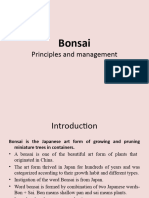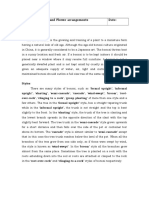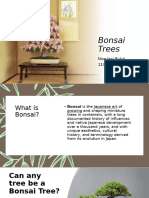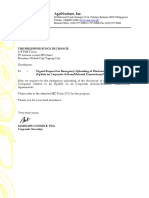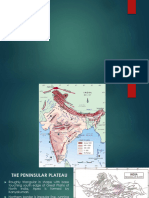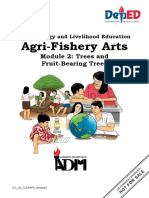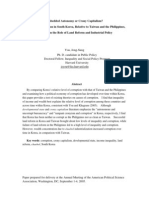Bonsai: Their Forms and Planting Techniques: October 2020
Bonsai: Their Forms and Planting Techniques: October 2020
Uploaded by
gylCopyright:
Available Formats
Bonsai: Their Forms and Planting Techniques: October 2020
Bonsai: Their Forms and Planting Techniques: October 2020
Uploaded by
gylOriginal Title
Copyright
Available Formats
Share this document
Did you find this document useful?
Is this content inappropriate?
Copyright:
Available Formats
Bonsai: Their Forms and Planting Techniques: October 2020
Bonsai: Their Forms and Planting Techniques: October 2020
Uploaded by
gylCopyright:
Available Formats
See discussions, stats, and author profiles for this publication at: https://www.researchgate.
net/publication/344447897
Bonsai: their forms and planting techniques
Article · October 2020
CITATIONS READS
0 2,589
4 authors, including:
Udit Joshi
Hemwati Nandan Bahuguna Garhwal University
35 PUBLICATIONS 3 CITATIONS
SEE PROFILE
Some of the authors of this publication are also working on these related projects:
Morphological Characterization and Genetic Variability and Divergence studies in Okra [Abelmoschus esculentus (L.) Moench] Under Valley Conditions of Garhwal Himalayas
View project
All content following this page was uploaded by Udit Joshi on 02 October 2020.
The user has requested enhancement of the downloaded file.
Bonsai:
Their Forms and
Planting Techniques
The art of bonsai has spread all across the
world, turning the once rather restricted discipline
into an appealing and relaxing hobby that anyone
Dr. Deepak Mewar can enjoy. The bonsai differs from a pot plant
Guest Faculty
Udit Joshi where, either the foliage or the flower is the main
M.Sc. Horticulture criterion but here the artistic look of the plant in a
Department of Horticulture,
H.N.B.G.U. (A Central
miniature form is maintained. This fascinating
University) Srinagar Garhwal hobby is not at all difficult to maintain and is an
Uttarakhand interesting art form. Anyone who sees bonsai is
Ruchin Negi
Time & Trends Academy,
amazed by the art and it quickly spread joy to the
Deccan Gymkhana, Pune, ones who sees it.
Maharashtra
Ajay Dhyani Introduction
Department of Floriculture and A bonsai is one of the beautiful art form of plants that
Landscaping, G.B.P.U.A&T
Pantnagar originated in China. The art form thrived in Japan for
hundreds of years and was categorized according to their
growth habit and different types. In around 13th century, there grew a culture of Japanese
collecting the forest trees that were dwarf by nature and by several training practices they
trained the trees for pot culture and reduced them more in size and were beautifully
designed. Whereas the naturally formed miniature trees plants were one of the first
September, 2020/Issue-5/Page |49
bonsai. These plants were found naturally in the mother nature and were beautifully
crafted by Japanese.
Instigation of the word Bonsai is from Japan. Word bonsai is formed by
combination of two Japanese words- nt,
which rendered as the pot or tray planting. As you can see in nature the old trees have
more prominent rounded canopy as compared to young trees, and also have more
drooping branches which makes them appear aged and elegant in looks and considered
more desirable for bonsai. Size of bonsai range from 5 inches to 30 inches in height.
Criteria for Selection of Plants
The selection of suitable plant for good bonsai is one of the most important choice
for the beginners. As we know that optimum size of Bonsai may be only upto 30 to 60
cm in height. For this all parts of the plants mainly trunk, branches, twigs, leaves etc
should be in the perfect proportion with the size of tree. The depth of the container and
the type of container used for planting should also be taken care of to provide better space
to the plant roots. And the material used should be eco-friendly. The plants selected
should also be according to the environmental conditions of that area. The plants should
be hardy in nature, and the various species of plant trees can be adopted according to
their growth habit and choice of the customers for market purpose. Mainly the small
leaved plants are preffered over broad and larger shaped leaves for making bonsai. The
leaves should be well managed, healthy and bright in colour that is having well shaded
green colour. The leaves should be dried up or of disorted shape.
The bark should be appealing and the trunk should be thicker at bottom as
compared to the top givng the illusion of maturity. Such trees gives good appearance
whose branches in the lower side are longer and bigger in diameter, as compared to the
upper side of the trunk. The upper side branches should be smaller in diameter giving
natural appearance to the tree. The adaptability of the plant to that area is also one of the
important factor for selection of tree for bonsai planting.
Plants suitable for Bonsai making
It was known several decades before that the Bonsai requires specific type of
plants but bonsai can be made from any of the naturally occurring pereninial woody
stemmed tree or the shrub species. From broad leaved evergreen to pines and conifers,
and also the deciduous trees can be used. The most popular plants used for bonsai are :
Ficus spp, Juniper Bonsai (juniperus), Bougainvillea spp, Duranta spp, Jasminum spp,
Murraya spp, Hamelia patens, Hibiscus rosea sinensis, Juniper chinensis, Neem,
Pine, Pomegranate, Poinsettia, Mini Kumquat, Sapota, Schefflera, Bottle Brush, Cypress
are some of the plants that make good bonsai.
September, 2020/Issue-5/Page |50
Styles of Bonsai
The art of Bonsai has groomed over the years and many
creative styles came into existence.
1. Formal Upright (Chokkan)
The most common style used in bonsai is formal upright. It
also resemble to the naturally growing of plants only when trees
does not face any natural harsh conditions. The trunk is kept
straight for upright growing and must be thicker at the bottom. The
trunk should be lower in proportion to the entire height of the tree.
Formal Upright
The branches should be kept alternate to each other that is kept to
suggest the age of tree sometimes.
2. Informal Upright (Mayogi)
It is also one of the most commonly used art of bonsai. This
art also resemble the natural habitat of the trees. This styles dispay
the curved trunk resembling harsh elements of nature. This style is
characterized by a lightly curving trunk displaying the harsh
elements of nature. The plants are trained and bend by use of wire
The preference is Informal
given to the deciduous trees and conifers as they are easily adaptable
in this style.
3. Broom (Hokidachi)
The broom style of bonsai are mostly suited for deciduous
trees having widespread and fine branching. The trunk is straight
and begins to divide into several branches resembling broom shape.
It makes a thick and ball shaped crown and gives a amazing look in
the winter months. Some of the examples used in broom style are
beech, elm, false cypress, and maple.
Broom
4. Slanting (Shakan)
This style of bonsai shows the tree is bend in one of the
particular direction. Mainly the leaned tree resembles tree grown
in shadow or bend towards sun. The branches are kept horizontal
droop slightly downward. The roots of the plants should be kept
in good care and well developed to keep the plant standing. The
roots in the surface of the plants shows unusual appearance and
well-anchored impression.
Slantin
September, 2020/Issue-5/Page |51
5. Windblown (Fukinagashi)
The plants of windblown style resemble the struggle for
survival. This type of trees are found rarely in nature, and are mostly
seen in cliffs or mojuntains. The trunk and branches are trained in
one direction to give the effect of strong wind and storm.
6. The Clasped-to-Stone (Ishisuki)
In this style, the roots of the tree are trained over the rocks. This Windblo
means that the tree struggle for its survival as there is not much room
for the roots and they starts growing over the rocks and in the holes
of stones. In this type the plants should be fertilized and watered
often, because there is proper space available to plant to store water.
Plants of clasped-to-stone style resemble age and tenacity.
7. Semi cascade (Han-kengai)
The semi cascade is somewhat similar to the cascade style. In
nature they are found in the cliffs or banks of rivers or lakes. The
trunk grows upright upto a considerable length and then is bend Clasped to stone
sidewards or downwards. The crown is above the rim of the
container or pot and branching occurs below the rim of the container.
8. Cascade (kengai)
In this style, the tree resembles as if planted in the steep cliff
and is bend downwards as if hanging over the ledge of the mountain.
Cascade style is one of the most difficult styles of Bonsai as it
opposes the natural growing tendency of the tree. The crown of the
tree mostly grows above the rim of the tree whereas the branches Semi-Cascade
grows subsequently below the rim of the container or vase.
The best time for planting of bonsai is in the autumn season when
the trees shed their leaves. The planting is done in the months of
February-March or July-August. You can also start planting when the
new buds open. The temperate plant crops such as cherry, plum peach
etc. are planted during the months of (Feb.-March). The potting of
the plants should not be done during severe hot months and during
very harsh winter months of the year.
Cascade
Source plants for making bonsai
September, 2020/Issue-5/Page |52
1. From seed: Seed are one of the most easily used method of planting of Bonsai. The
seeds are mostly sown in autumn season. The plants takes long time, for making of this
type of Bonsai but gives the best shape to the Bonsai. It makes the best bonsai.
2. From vegetatively propagated plants: For vegetative propagation of bonsai plants
cuttings are mostly used. It is one of the most commonly used methods and is also easily
available. The growth of plants is faster as compared to other methods. The other
methods such as grafting, budding and layering can also be adopted.
3. Seedlings from local origin/countryside: the seedlings of locally originated trees can
also be used for bonsai. The seedlings can be trained to an appropriate style without
injuring the plant parts. While collecting of seedlings of the trees care must be taken not
to injure the plant roots.
Shaping and styling bonsai
To get the better shape of plants one should have the proper knowledge about the
plant species used for bonsai. Most people generally think that the plants grown for
bonsai are genetically dwarf plants. But the plants are normal plants which are trained
by various classy techniques and maintained to a miniature sizes. One has to decide the
final shape and size of the bonsai tree even before planting. A proper plan should be
made on the paper sheet, and a sketch of the style that you wish to create.
Shape and style on the bonsai includes basic methods such as pruning, wiring, and
pinching. The methods have to perform regularly or in a particular time interval. The
plant has to be pruned to maintain and refine the shape of the tree. The regular pruning
has to be done in the top of the trees. It can be done throughout the year but mostly during
the months of March and September. As the upper part of the tree has the most apical
dominance, to encourage growth to inner parts of the tree. Pruning has to be done with
proper care and in a good proportion. Pinching is to be done to reduce the total leaf area
if the ratio is not maintained properly the plant may wilt. The pinching ot the branches
is also done to give the plant an artistic shape. The root pruning is also one of the essential
operation in plants to give the proper proportion to the plants and maintain its size. Also
it helps the roots to not bulge out of the container. Root pruning is done during the
transplanting and repotting of the plant.
Another important technique to shape Bonsai is the wiring. It is the crucial technique
to train the bonsai trees. For bending the branches, copper wire is best as it is pliable.
Before using the wire it should be heated to make it pliable, then cooled before using.
When wiring a branch, first wind the wire around the trunk several times and then around
the branch. While winding a branch the union with the trunk is to be held with one hand
or otherwise the joint may snap. The wire coils should be spaced evenly by about 0.5 to
September, 2020/Issue-5/Page |53
0.6cm apart. To give the specific shape, the wire has to be in place for several years, but
rewinding is to be done every six months to avoid injury to the bark mainly done during
the growth seasons as the wire may cut into the bark. This may create scars in the
branches therefore should be taken care and trees have to be unwired in a regular time
period.
Bonsai Containers
The selection of container is one of the most important consideration in bonsai trees.
The container should be of proper depth and must be in proper proportion to the plant
growth. It must look attractive and should be durable. The shape of the container can be
round, oval or rectangular. For a single upright stem, an oval or round container will suit
better while for the cascade style a rectangular container looks more artistic. An unglazed
container is preferred as it allows aeration of the soil. The color of the co ntainer should
be as natural as possible.
Care and maintenance
Soil mix
The soil mix used for bonsai should be of such a nature that it will not become
waterlogged or sour and should not be rich in manures. The chemical reaction of the soil
should be close to neutrality. Good soil mix will be made up of 2 parts of Loamy Soil or
Coco-Peat, 1 and 1/2 parts coarse river sand, and 1 part leaf litter.
Watering
As Bonsai grows on shallow containers, watering is an important aspect. During the
summer months, watering three times a day is necessary. The compost should be filled
in a container leaving about 2 3cm space from the brim to facilitate watering. One way
of ensuring whether a plant needs watering is to tap the container with a wooden hammer
on the sides. If a dull sound comes out, the plant should not be watered. But if there is a
ringing tone, the plant needs watering.
Manuring
Manuring is needed for proper vegetative growth and to encourage flowering or
fruiting. Generally, manuring is done twice a year, once during the spring and again
during the rainy season. Too much manuring should be avoided as this may cause soft
and sappy growth.
Repotting
The fast-growing plants need repotting every year, while the slow-growing plants
may be repotted every 2- 3 years. The plant is removed out of the pot gently with the
September, 2020/Issue-5/Page |54
View publication stats
September, 2020/Issue-5/Page |55
earth ball and all drainage materials are removed. 1/3 of the old subsoil is removed. Soil
stuck up between a few of the roots may be removed. Any root that is longer than what
is accommodated in the container, is cut with a secateur. The plant is then placed in a
position in the container and compost is filled in. The plant is immediately watered.
Conclusion
In this article you must have learned some facts about bonsai but there is more you
can learn just by practicing this beautiful art form. The art of bonsai has spread all across
the world, turning the once rather restricted discipline into an appealing and relaxing
hobby that anyone can enjoy. The Bonsai differs from a pot plant where, either the
foliage or the flower is the main criterion but here the artistic look of the plant in a
miniature form is maintained. This fascinating hobby is not at all difficult to maintain
and is an interesting art form. This art form brings patience in the individual. It has long
been admired in the art of Feng Shui thought as they bring positive energies to the room
or the place grown. Anyone who sees bonsai is amazed by the art and it quickly spread
joy to the ones who sees it. The oldest bonsai is believed to have lived over 800 years.
That Bonsai you buy today could become an heirloom, passed down in the family, and
treasured by generations to come.
References
Chadha, K. L. and Bhattacharjee. (1986). Ornamental Hortculture in
India. ICAR, New Delhi.
Korner, C., S. P. Menendez-Riedl, and P. C. L. John. (1989). Why Are
Bonsai Plants Small? A Consideration of Cell Size. Australian Journal of
Plant Physiology. 16: 443-448.
Raj, D. (2004). Floriculture at Glance. Kalyani Publisher, Ludhiyana.
Randhawa, G. S. and Mukhopadhyay, A. (2010). Floriculture in India.
Allied publishers private limited. New Delhi.
Relf, D. (2015). The Art of Bonsai. Produced by Communications and
Marketing, College of Agriculture and Life Sciences, Virginia Polytechnic
Institute and State University. www.ext.vt.edu.
August, 2020/Issue-4/Page |55
You might also like
- On Downtown and DemesnesDocument254 pagesOn Downtown and DemesnesFrodo93% (15)
- Bonsai ProjectDocument25 pagesBonsai ProjectVicky Singh100% (1)
- Curse On BeregostDocument9 pagesCurse On BeregostmNo ratings yet
- Presentation On Quality ControlDocument78 pagesPresentation On Quality ControlBipin Yadav100% (2)
- Cabbage Production JICADocument68 pagesCabbage Production JICAgyl100% (2)
- TATA Chemicals LTDDocument40 pagesTATA Chemicals LTDAnirudh A RaneNo ratings yet
- Agriculture BrandingDocument11 pagesAgriculture BrandingH.RAJU MNo ratings yet
- BonsaiDocument8 pagesBonsaiAllanNo ratings yet
- BonsaiDocument8 pagesBonsaiBaby Sri Divya DavuluriNo ratings yet
- Bonsai PDFDocument8 pagesBonsai PDFNguyen DatNo ratings yet
- Bonsai 20241017 184523 0000Document40 pagesBonsai 20241017 184523 0000Priya YadavNo ratings yet
- BonsaiDocument19 pagesBonsaiVINTAGE LOVER 17No ratings yet
- BonsaiDocument43 pagesBonsaiTitus ErhadiNo ratings yet
- Ebook Bonsai UKDocument34 pagesEbook Bonsai UKN100% (1)
- 426-601 PDF PDFDocument6 pages426-601 PDF PDFThang TongNo ratings yet
- Bonsai Symbol of Culture Ideals Money AnDocument4 pagesBonsai Symbol of Culture Ideals Money AnJavier RodríguezNo ratings yet
- Bonsai RawDocument31 pagesBonsai Rawmahnoorsadiq193No ratings yet
- BonsaiDocument16 pagesBonsaiLoganathan ChinnasamyNo ratings yet
- Bonsai for Beginners Book: A Comprehensive Guide on the Art of Growing and Caring for Your Bonsai Tree. A Bonsai Instruction Book from Basic to the Most Advanced Techniques to Make Your Bonsai Healthy and Live LongFrom EverandBonsai for Beginners Book: A Comprehensive Guide on the Art of Growing and Caring for Your Bonsai Tree. A Bonsai Instruction Book from Basic to the Most Advanced Techniques to Make Your Bonsai Healthy and Live LongNo ratings yet
- Japanese (Bo ɰ ̃sai) : Bonsai (Document1 pageJapanese (Bo ɰ ̃sai) : Bonsai (Yan Linn AungNo ratings yet
- Bonsai: MURODA, Kristel Marie F. BS Architecture III Planning IDocument56 pagesBonsai: MURODA, Kristel Marie F. BS Architecture III Planning IKristel Marie MurodaNo ratings yet
- The Ancient Art of BonsaiDocument17 pagesThe Ancient Art of BonsaiAntonio_S_Lima100% (1)
- Bonsai: A Comprehensive Guide to Growing, Pruning, Wiring and Caring for Your Bonsai TreesFrom EverandBonsai: A Comprehensive Guide to Growing, Pruning, Wiring and Caring for Your Bonsai TreesNo ratings yet
- The Little Book of Bonsai: An Easy Guide to Caring for Your Bonsai TreeFrom EverandThe Little Book of Bonsai: An Easy Guide to Caring for Your Bonsai TreeNo ratings yet
- Bonsai Plants: Bring The Forest Home: December 2016Document5 pagesBonsai Plants: Bring The Forest Home: December 2016dari03No ratings yet
- Bonsai: Specialist Guide: Buying, planting, displaying, improving and caring for bonsaiFrom EverandBonsai: Specialist Guide: Buying, planting, displaying, improving and caring for bonsaiNo ratings yet
- Im Only Uploading This With: The Intention of Stealing A Document. Much Love 3Document3 pagesIm Only Uploading This With: The Intention of Stealing A Document. Much Love 3imstealingdisNo ratings yet
- Bonsai BookDocument33 pagesBonsai Bookmahnoorsadiq193No ratings yet
- Bonsai EditedDocument40 pagesBonsai Editedmahnoorsadiq193No ratings yet
- BonsaiDocument22 pagesBonsaiSarita AgrawalNo ratings yet
- Ex - No 15 Bonsai and Flower ArrangementDocument8 pagesEx - No 15 Bonsai and Flower ArrangementViji ThulasiramanNo ratings yet
- Bonsai 1Document11 pagesBonsai 1reyamoloNo ratings yet
- Bonsai Guide For The BeginnerDocument21 pagesBonsai Guide For The BeginnerVidhyaa Saagar0% (1)
- Bonsai for Beginners: A Step-By-Step Guide to Choosing, Growing & Caring for BonsaiFrom EverandBonsai for Beginners: A Step-By-Step Guide to Choosing, Growing & Caring for BonsaiNo ratings yet
- 426-601 PDF PDFDocument6 pages426-601 PDF PDFNeural Spark Physics Cie100% (1)
- The Little Book Of Bonsai: Types, Styles, Care, Pruning, Growing Tips, Tools, Does and Dont'sFrom EverandThe Little Book Of Bonsai: Types, Styles, Care, Pruning, Growing Tips, Tools, Does and Dont'sNo ratings yet
- Beginners ManualDocument58 pagesBeginners ManualPrasaf100% (3)
- A Quick Fix BonsaiDocument8 pagesA Quick Fix BonsaiNicolás Solano CondeNo ratings yet
- BonsaiDocument5 pagesBonsaiin707ciNo ratings yet
- The Fascinating World of Bonsai TreesDocument1 pageThe Fascinating World of Bonsai Treestempuser69No ratings yet
- Bonsai EbookDocument24 pagesBonsai EbookMatija PoljakNo ratings yet
- The World of Bonsai TreesDocument12 pagesThe World of Bonsai TreesMerry Oktavia100% (1)
- Horticulture Landscaping Bonsai1Document5 pagesHorticulture Landscaping Bonsai1mohanNo ratings yet
- Complete Starter Guide to Bonsai: Growing from Seed or Seedling--Wiring, Pruning, Care, and DisplayFrom EverandComplete Starter Guide to Bonsai: Growing from Seed or Seedling--Wiring, Pruning, Care, and DisplayNo ratings yet
- Bonsai EbookDocument24 pagesBonsai EbookAmandaNo ratings yet
- Bonsai for Beginners: The Essential Art and Guide of Growing and Taking Care of a Bonsai Tree. A Step-by-Step Guide from Basics to the Most Advanced Techniques to Make It Healthy and Long-LastingFrom EverandBonsai for Beginners: The Essential Art and Guide of Growing and Taking Care of a Bonsai Tree. A Step-by-Step Guide from Basics to the Most Advanced Techniques to Make It Healthy and Long-LastingNo ratings yet
- How To Grow Miniature TreesDocument20 pagesHow To Grow Miniature TreesLuis DiasNo ratings yet
- Bonsai for Beginners: The Joy of Bonsai: Growing, Shaping, and Displaying Your Own Living Works of ArtFrom EverandBonsai for Beginners: The Joy of Bonsai: Growing, Shaping, and Displaying Your Own Living Works of ArtNo ratings yet
- BonsaiDocument1 pageBonsaigirumasNo ratings yet
- The Art of Bonsai - Cultivating Nature in MiniatureDocument2 pagesThe Art of Bonsai - Cultivating Nature in Miniaturetsb56625No ratings yet
- Bonsai For Beginners - The Complete Guide To Bonsai Care And Techniques For BeginnersFrom EverandBonsai For Beginners - The Complete Guide To Bonsai Care And Techniques For BeginnersNo ratings yet
- Bonsai For Beginners: The Ultimate Guide to Growing Your Bonsai TreeFrom EverandBonsai For Beginners: The Ultimate Guide to Growing Your Bonsai TreeRating: 1 out of 5 stars1/5 (1)
- John Ainsworth - The Secret Art of Bonsai RevealedDocument15 pagesJohn Ainsworth - The Secret Art of Bonsai RevealedVishal Arora100% (2)
- Bonsai00shar PDFDocument148 pagesBonsai00shar PDFBrian-Marti Boatright100% (1)
- BONSAI LabDocument33 pagesBONSAI LabMuhammad MushtaqNo ratings yet
- Bonsai Objectives... in A Nutshell: 1. Dramatic Surface RootsDocument2 pagesBonsai Objectives... in A Nutshell: 1. Dramatic Surface RootsAlessioMasNo ratings yet
- Bonsai: The Complete and Comprehensive Guide for BeginnersFrom EverandBonsai: The Complete and Comprehensive Guide for BeginnersRating: 1 out of 5 stars1/5 (1)
- Horticulture - Landscaping - BonsaiDocument4 pagesHorticulture - Landscaping - BonsaiVINTAGE LOVER 17No ratings yet
- CONTAINER, The Chinese Word For Bonsai Is PUN-JAI - The 1. How To Make A BonsaiDocument4 pagesCONTAINER, The Chinese Word For Bonsai Is PUN-JAI - The 1. How To Make A BonsaiAshok ChittaragiNo ratings yet
- Bonsai Tree Trimming Sculpting Pruning 1Document6 pagesBonsai Tree Trimming Sculpting Pruning 1Adi Sutrisna0% (2)
- Sweet Pepper Production JICADocument68 pagesSweet Pepper Production JICAgylNo ratings yet
- Onion Cultivation JICADocument64 pagesOnion Cultivation JICAgylNo ratings yet
- UntitledDocument1 pageUntitledgylNo ratings yet
- CHILI ProductionDocument69 pagesCHILI ProductiongylNo ratings yet
- POTATO Production JICADocument64 pagesPOTATO Production JICAgylNo ratings yet
- Crop Planting Calendar JICADocument20 pagesCrop Planting Calendar JICAgylNo ratings yet
- Watermelon GuidebookDocument66 pagesWatermelon Guidebooksamuel malashaNo ratings yet
- Ani Amended DisDocument269 pagesAni Amended DisgylNo ratings yet
- Agrinurture, Inc.: The Philippine Stock ExchangeDocument3 pagesAgrinurture, Inc.: The Philippine Stock ExchangegylNo ratings yet
- Ormoc - Google MapsDocument3 pagesOrmoc - Google MapsgylNo ratings yet
- SHLPH 2019 Integrated Annual Corporate Governance Report (I-ACGR) - RedactedDocument67 pagesSHLPH 2019 Integrated Annual Corporate Governance Report (I-ACGR) - RedactedgylNo ratings yet
- Securities and Exchange Commission: Sec Form 17-C, As AmendedDocument4 pagesSecurities and Exchange Commission: Sec Form 17-C, As AmendedgylNo ratings yet
- Canada Life Announces 2020 Participating Policyowner Dividend ScaleDocument1 pageCanada Life Announces 2020 Participating Policyowner Dividend ScalegylNo ratings yet
- Securities and Exchange Commission: Sec Form 17-C, As AmendedDocument2 pagesSecurities and Exchange Commission: Sec Form 17-C, As AmendedgylNo ratings yet
- SHLPH - PSE Form 17-12 - Top 100 Stockholders As of 30 June 2020Document5 pagesSHLPH - PSE Form 17-12 - Top 100 Stockholders As of 30 June 2020gylNo ratings yet
- Participating Policyholder Dividend Policy: The Canada Life Assurance Company (The Company)Document3 pagesParticipating Policyholder Dividend Policy: The Canada Life Assurance Company (The Company)gylNo ratings yet
- Modular Prefabricated Housing Literature ScanDocument80 pagesModular Prefabricated Housing Literature ScangylNo ratings yet
- Master Plan.Document1 pageMaster Plan.Hikmat AyerNo ratings yet
- Strategic Factor Analysis For Exporter of Robusta Coffee Bean From Lampung, South Sumatra, IndonesiaDocument7 pagesStrategic Factor Analysis For Exporter of Robusta Coffee Bean From Lampung, South Sumatra, IndonesiasfasffNo ratings yet
- Fanoos Haider CV (1)Document3 pagesFanoos Haider CV (1)fanooshaideraaurNo ratings yet
- Winsem2014-15 Cp0670 17-Apr-2015 Rm01 U4 l4 Rainwater-HarvestingDocument12 pagesWinsem2014-15 Cp0670 17-Apr-2015 Rm01 U4 l4 Rainwater-HarvestingShiv ShivNo ratings yet
- Optical Distortion Inc.: Presented byDocument26 pagesOptical Distortion Inc.: Presented byDhruv GandhiNo ratings yet
- Growing Adeniums in The Rainy Season PDFDocument4 pagesGrowing Adeniums in The Rainy Season PDFNorberto R. Bautista50% (2)
- Paper 1 General Studies-I: Indian Heritage and Culture, History and Geography of The World and SocietyDocument4 pagesPaper 1 General Studies-I: Indian Heritage and Culture, History and Geography of The World and Societyanon_56564465No ratings yet
- Cactus ReviewDocument20 pagesCactus ReviewLinx_ANo ratings yet
- BFTH-Plant Families PDFDocument8 pagesBFTH-Plant Families PDFYekitaSNo ratings yet
- Classification of Soil Plus NumericalsDocument5 pagesClassification of Soil Plus NumericalsATS cartoon'sNo ratings yet
- Previous Year GK Questions SSCDocument320 pagesPrevious Year GK Questions SSCSachu S0% (1)
- Peninsular PlateauDocument17 pagesPeninsular PlateauRaghvendra SinghNo ratings yet
- Avoidable Food CombinationsDocument4 pagesAvoidable Food Combinationsvksk1951No ratings yet
- Agri-Fishery Arts: Module 2: Trees and Fruit-Bearing TreesDocument30 pagesAgri-Fishery Arts: Module 2: Trees and Fruit-Bearing TreesFritzy Premaylon92% (13)
- AVO - UC IPM Pest Management Guidelines For Avocados PDFDocument93 pagesAVO - UC IPM Pest Management Guidelines For Avocados PDFMeggie DuongNo ratings yet
- Book National Cashew Polity KH - FinalDocument106 pagesBook National Cashew Polity KH - FinalnatkininnNo ratings yet
- Malwa School Question Paper Half YearlyDocument4 pagesMalwa School Question Paper Half YearlypardeepbthNo ratings yet
- University of GondarDocument39 pagesUniversity of GondarMuket Agmas100% (1)
- Grade 8 Jss s2 Midterm 1 Exams 2024Document87 pagesGrade 8 Jss s2 Midterm 1 Exams 2024AretinaNo ratings yet
- Garlic ProductionDocument40 pagesGarlic ProductionGtNo ratings yet
- Embedded Autonomy or Crony Capitalism Explaining Corruption in South Korea Relative To Taiwan and The Philippines Focusing On The Role of Land Reform and Industrial PolicyDocument45 pagesEmbedded Autonomy or Crony Capitalism Explaining Corruption in South Korea Relative To Taiwan and The Philippines Focusing On The Role of Land Reform and Industrial PolicyaalozadaNo ratings yet
- DA AO 26 2007 Guidelines Waste Water Reuse For Irrigation AgricultureDocument37 pagesDA AO 26 2007 Guidelines Waste Water Reuse For Irrigation AgricultureBoni MagtibayNo ratings yet
- Universal Soil Loss Equation (USLE)Document10 pagesUniversal Soil Loss Equation (USLE)Rashmi RaniNo ratings yet
- Syllabus AgrarianDocument25 pagesSyllabus AgrarianApriele Rose Gaudicos HermogenesNo ratings yet
- Carry Out Harvest and PostharvestDocument67 pagesCarry Out Harvest and PostharvestAllen Jade PateñaNo ratings yet































